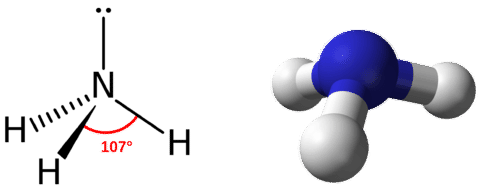Nh3 Lewis Structure Molecular Geometry
NH3 Lewis Structure, Molecular Geometry, Hybridization, Bond Angle & Shape
Ammonia is a colorless compound, used in making fertilizers. Information technology is a stable hydride formed of i nitrogen and three hydrogen atoms. The molecule has a pungent smell. Information technology can form an NH4+ ion by accepting a proton. In this blog post, we will larn about the Lewis dot structure, electron geometry, and molecular geometry of this molecule.
| Name of molecule | Ammonia / Nitrogen Trihydride ( NH3) |
| No of Valence Electrons in the molecule | 8 |
| Hybridization of NH3 | sp3 hybridization |
| Bond Angles | 107 degrees |
| Molecular Geometry of NH3 | Trigonal Pyramidal |
And to empathize the Lewis structure, we beginning need to find out the valence electrons in this molecule. Electrons in the cantlet's outermost shell are termed as valence electrons and are vital for as they are responsible for forming bonds equally well as the structure of the molecule.
Valence electrons of NH3 ( Ammonia )
Nitrogen is a grouping 15 element and has five electrons in its outer shell. In dissimilarity, Hydrogen is a group 1 chemical element and only has 1 valence electron in its outer shell. To get the full number of valence electrons, we will add together upwardly the valence electrons for both these atoms.
Nitrogen – five valence electrons
Hydrogen – 1 electron, but every bit there are 3 Hydrogen atoms nosotros will multiply it past 3, there are three valence electrons of all Hydrogen atoms.
Total number of valence electrons – 5+3
= 8 valence
Ammonia or NH3 has a total of 8 valence electrons.
NH3 Lewis Structure
The Lewis structure of a molecule helps empathize the electron geometry, molecular geometry, polarity, and other such properties with ease. It is a pictorial representation of the organization of valence electrons effectually the individual atoms in the molecule. The electrons that form bonds are chosen bonding pair of electrons, whereas the ones that do not course any bonds are called nonbonding pairs of electrons or lone pairs of electrons.
Dots are used to show the valence electrons, whereas the lines correspond bonds in the structure. Here is the footstep-past-step procedure to sympathise the Lewis structure of NH3.
Now that we know the valence electrons for the molecule, nosotros can predict its Lewis structure. Hydrogen atoms never take the central position, so we volition place the Nitrogen atom in the center.
Place all the Hydrogen atoms around the Nitrogen atom and the valence electrons of both the atoms like this.
Each Hydrogen cantlet just needs 1 electron to get stable, as information technology is an exception to the octet rule. Nitrogen will share three of its valence electrons for forming a stable structure.
Thus at that place are three single bonds formed between Nitrogen and Hydrogen atoms, and at that place is one pair of nonbonding electrons on the nitrogen atom.
NH3 Molecular Geometry
Ammonia has a tetrahedral molecular geometry. All the Hydrogen atoms are arranged symmetrically around the Nitrogen cantlet which forms the base, and the two nonbonding electrons form the tip which makes the molecular geometry of NH3 trigonal pyramidal.
NH3 Hybridization
The Nitrogen atom has the electronic configuration of 1s2 2s2 2px1 2py1 2pz1. When it shares the electrons with Hydrogen atoms, ane southward-orbital and three p-orbitals hybridize and overlap with s orbitals of a Hydrogen cantlet to form sp3 hybridization.
Thus, Ammonia or NH3 has sp3 hybridization.
NH3 Bond angles
There are three unmarried bonds and ane lone pair of electrons in the NH3 molecule. Information technology has a molecular geometry of trigonal pyramidal which also looks like a distorted tetrahedral construction. The shape is distorted considering of the solitary pairs of electrons. This pair exerts repulsive forces on the bonding pairs of electrons. Although the bond angle should be 109.five degrees for trigonal pyramidal molecular geometry, it decreases to 107 degrees due to the lone pair on the nitrogen atom.

Concluding Remarks
Ammonia is a stable binary hydride having a Trigonal Pyramidal molecular geometry and sp3 hybridization. It has bond angles of 107 degrees and an electron geometry of tetrahedral. To know more nigh its polarity, read our blog on polarity .
Nh3 Lewis Structure Molecular Geometry,
Source: https://geometryofmolecules.com/nh3-hybridization-bond-angle-molecular-shape/
Posted by: rochastemblitrand84.blogspot.com


0 Response to "Nh3 Lewis Structure Molecular Geometry"
Post a Comment